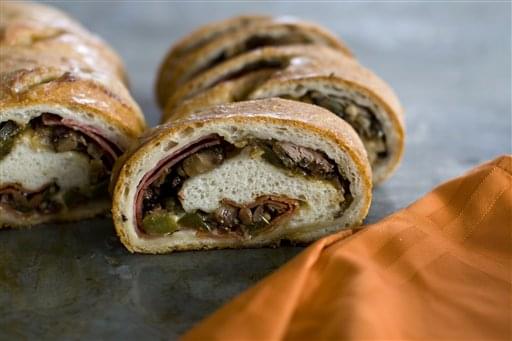What’s the Difference between…
A CALZONE AND A STROMBOLI
There are some pretty iconic mother-child duos out there. Mary and Jesus, for one. Rory and Lorelai Gilmore. The mom and daughter in Mamma Mia. Joining the ranks: Pizza and her large adult sons, calzone and stromboli.
And while the two boys certainly take after their mother— they’re all made up of dough, cheese, and sauce, and the toppings you’d find on Mom live inside their bellies — their traits present in different ways. Here’s how to tell them apart.
Seal
A calzone is folded in half, with its edges crimped (like a dumpling). A stromboli is rolled into a spiral (like a burrito), then sealed off with more dough.
Shape
A calzone is shaped like a half moon. A stromboli looks like an elongated rectangle, with rounded edges.
Cooking Method
Stromboli are baked. Calzones can be baked or fried.
Serving Size
Calzones generally serve 1 or 2 people. Stromboli serve a party.
Origin
Calzones were born in Naples, Italy as a more-portable alternative to pizza. Stromboli come from South Philly, and are either named after the 1950 Roberto Rossellini film Stromboli starring Ingrid Bergman OR after the Isle of Stromboli, home to a volcano named Mount Stromboli that has been erupting almost continuously since 1932 and is one of the most active volcanoes on Earth.
Filling
Both can be filled with pretty much anything: cheese, meat, vegetables, etc. BUT: Calzones usually include ricotta, and stromboli usually include mozzarella.
Sauce
You’ll rarely find sauce inside a calzone’s pocket; it’s instead served in a separate vessel for dipping. Stromboli oftentimes have sauce in their filling, but they can be served with a sidecar, too.
About The Author
 What\’s the Difference is a newsletter created by Brette Warshaw, a consultant and writer living in New York City. She has worked with companies such as RAMONA, OpenTable, LIVELY, Food52, and Open Society, and she was the Chief Operating Officer of the late cult food magazine Lucky Peach. She studied history and creative writing at the University of Pennsylvania, and wrote her thesis on Jell-O marketing in the Great Depression. In her spare time, she enjoys throwing dinner parties and organizing her pantry.
What\’s the Difference is a newsletter created by Brette Warshaw, a consultant and writer living in New York City. She has worked with companies such as RAMONA, OpenTable, LIVELY, Food52, and Open Society, and she was the Chief Operating Officer of the late cult food magazine Lucky Peach. She studied history and creative writing at the University of Pennsylvania, and wrote her thesis on Jell-O marketing in the Great Depression. In her spare time, she enjoys throwing dinner parties and organizing her pantry.
